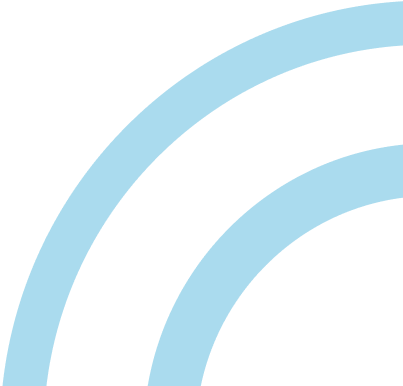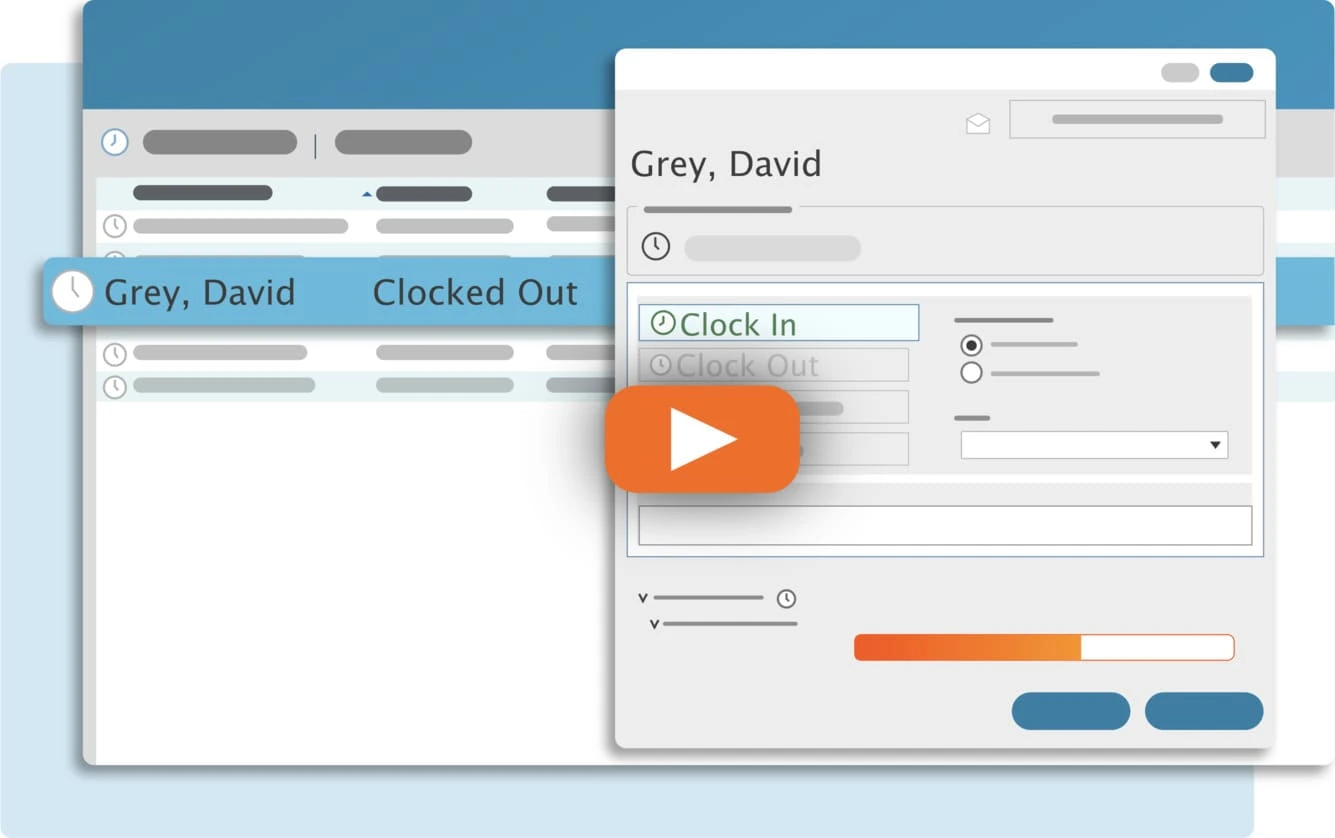Every company, no matter the industry or size, is going to have to run payroll at some point. And in order to run payroll, tracking the time its employees worked is a necessity. How that time is tracked, though, is up to the company.
Here, I've analyzed two types of employee time trackers so you can decide what solution is best for your business.
Table of Contents
- An Introduction to Employee Kiosks
- Types of Employee Kiosks
- Common Employee Kiosk Features
- Pros
- Cons
- Price
- An Introduction to Time Clock Software
- Types of Time Clock Software
- Common Time Clock Software Features
- Pros
- Cons
- Price
- Which One is Better?
- Can TimeClick Fulfill All Your Needs?
- Final Thoughts
An Introduction to Employee Kiosks
An employee kiosk can be anything from a small pin pad machine to a tablet with a downloaded app. Purposed with tracking employee time securely, they are usually in one location and do not allow for employees to clock in and out from anywhere else.

Types of Employee Kiosks
Paper Timestamp
Besides writing down employee clock in and out times on a piece of paper with a pencil, nothing gets more old-school than a paper time card and stamp. The paper timestamp machine is used by placing a punch card in the machine and pressing a button. Then, the machine will stamp the date and time on the time card for when the employee has clocked in or out.
Physical Pin Pad Machine
You might call a physical pin pad time clock kiosk a more modernized version of the paper timestamp, but it can vary in many ways. This type of employee time clock is more likely to have built-in biometrics such as a fingerprint reader. They are also usually mounted on the wall and allow employees to punch in their password or scan their finger to clock in and out.
Touchscreen Machine
Just like a pin pad machine, a touch screen time clock kiosk will simply allow employees to enter a password to clock in and out. These machines are more likely to have a facial recognition biometric and can come in various forms, such as wall-mounted or stand-alone kiosks.
App
A time clock app turned into an employee kiosk is one of the most flexible and mobile kiosk solutions. If you already have a device, such as a tablet, to use as an employee kiosk, a time clock app that works with that device can be a great money-saver.
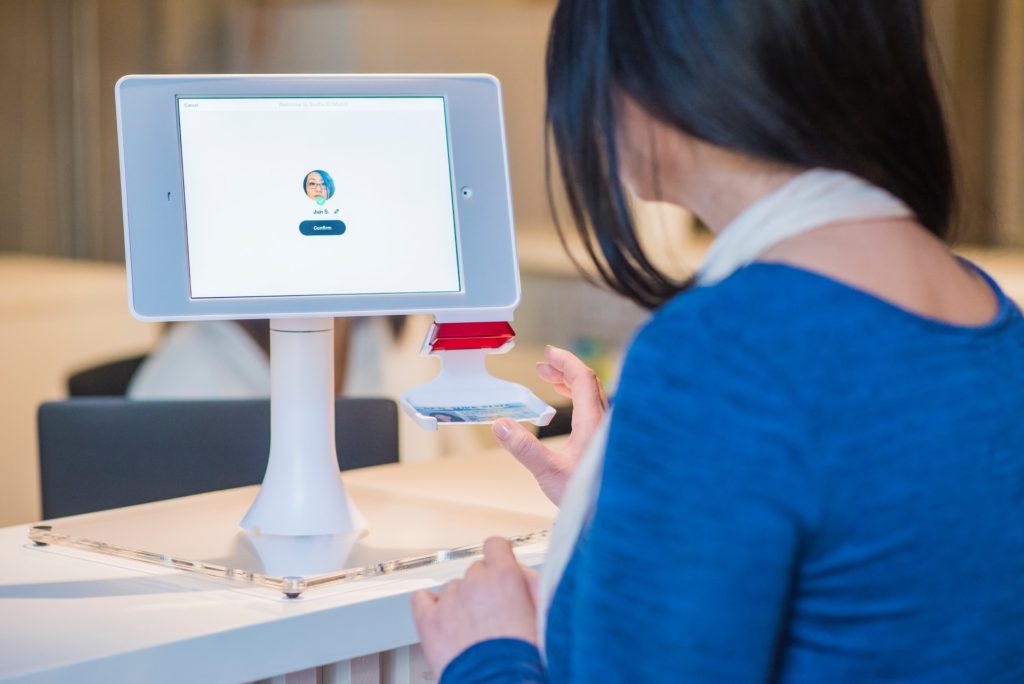
Common Employee Kiosk Features
Employee Punch In/Out
Though it may seem obvious, I had to include the employee punch in and out on the features list because it is the most important feature in any employee time clock. Every employee kiosk will have this, though each may have a different way of doing it. You just have to decide which method is best for you: scanning a fingerprint or typing in a password.
Biometrics
Biometrics are security features put in place to prevent employees from buddy punching or stealing time in other ways. They can greatly decrease the amount of your company funds that are unnecessarily spent on dishonest employees. Here are some of the types of biometrics you might see in an employee kiosk:
-
- Fingerprint Scanner
-
- Facial Recognition
-
- Pin Code (Password)
-
- RFID Card Sensors
Ethernet/Wi-Fi
Since an employee kiosk is not already connected to a computer, many will connect to either Wi-Fi or ethernet. This is so you can view and print your reports on your computer. It also may connect with an additional software you can download on your computer that allows you to manage your employees and time reports.
Touchscreen
A touchscreen may not be necessary, but it can be a nice addition to the regular time clock software features, making navigating a time clock kiosk easier and probably a bit more fun.
Printer
Though printers are less common on employee kiosks, I have seen them on some, and I think they could be beneficial in some ways . The printer will simply print a basic time report on receipt paper. It's a great way to get the employee data quickly without having to look at a computer.
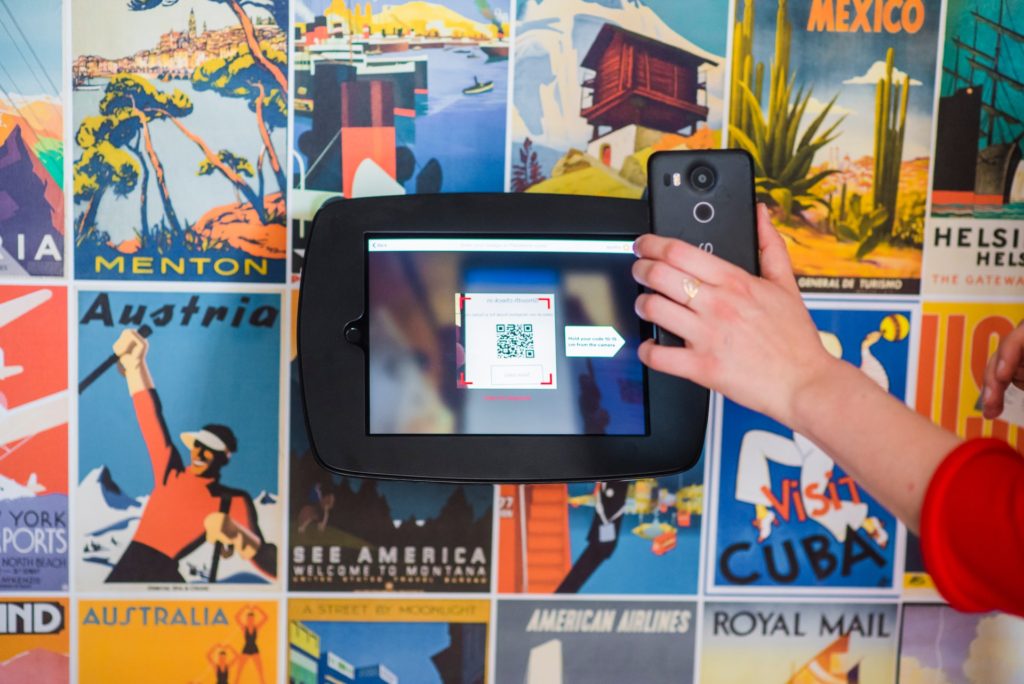
Pros
They're paper-free (mostly)
Unless you use the paper timestamp, employee kiosks are virtually paper-free. This cleans up the mess of keeping track of the paper with recorded times and gives much less room for human error. With the benefit of paper-free time tracking, employees don't have to remember when they clocked in or out. It's already recorded within the kiosk.
Security
If you've ever heard of buddy punching, you know it can cost your company a lot of money. Essentially, buddy punching is when an employee gets their coworker to clock in for them so they still get paid without actually working. It's a very common problem in companies all over the country. You can solve this issue by ensuring there are extra security features in the time clock you use. Employee kiosks tend to have higher security with biometrics such as fingerprint scanners and facial recognition.
They stay in one place
To add to the security of biometrics, employee kiosks usually stay in one place in your work area, making it impossible for employees to clock in or out from where they're not supposed to.
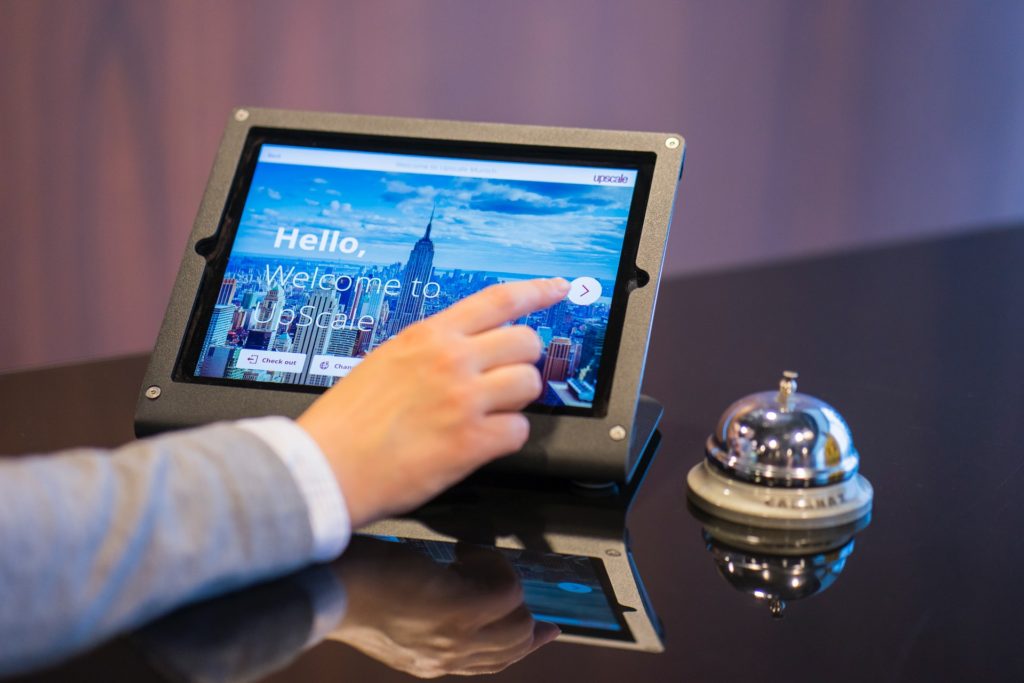
Cons
It's just another machine to buy
Though it can be useful to have a designated time clock, and they are much less expensive than purchasing an entire computer, it's just another expense if you already have a computer to use.
The space could get crowded
If you have several employees scheduled to clock in or out at the same time, it can get crowded when you only have one employee kiosk. This could create unfair circumstances if employees are having to wait to clock in or out until after their scheduled time.
They're not movable
An employee kiosk is meant to stay in one place at all times. This makes remote work or specific jobs that require transportation difficult or impossible to clock in and out for.
The features are restrictive
Employee kiosks tend to have less features than a software might have. For example, running reports can be a much more complicated process on a kiosk rather than with a time clock software.
They could become outdated
Any machine or software is going to need to be updated at some point. Technology is ever-changing and improving. But updating an employee kiosk can be much more expensive and complicated than updating a time clock software. When it's outdated, you have to purchase a whole new machine in order to keep your employee time tracking fast and effective.
Price
The price of an employee kiosk can vary depending on what gadgets and features each one has. I've seen kiosk price range from $100 - $1,000. If you are looking at purchasing an employee kiosk, you'll need to research what options are available and what is going to best fit your company's needs.
Simplify Time Tracking with TimeClick!
Download our free trial—simple, secure, offline tracking, no fluff.
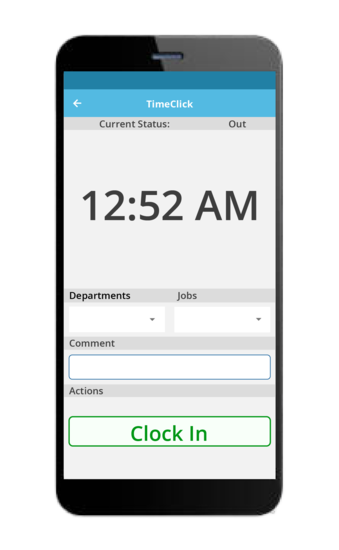
An Introduction to Time Clock Software
Time Clock Software only started to develop and become more popular these past two decades. It's an entirely virtual time clock system that allows you to not only track employee time, but usually includes other extremely useful employee management features as well.

Types of Time Clock Software
On-Premise Software
An on-premise time clock software is stored only on your local network. In other words, the data from the software is only on your computer and the other computers in your office, which means you cannot access it from other locations. It's great to use when you have a small company with employees that only work in office.
Cloud Software
A time clock software that's based in the cloud stores all your data in a cloud service, making it accessible from anywhere that has an internet connection. It's great for remote work and for backing up your data in case your computer ever decides to go kaput.
App
A time clock app is similar to a cloud software, but it is available to download and use on a mobile device such as a phone or tablet. This makes clocking in and out on the go much easier and more accessible.

Common Time Clock Software Features
Employee Time Tracking
As said before, with employee kiosks, employee time tracking is the most basic and important time clock feature. Every time clock software will have it, this time more likely to include other features as well, such as fixing times when an employee forgets to clock in or out.
Reports
One benefit of time clock software is that all your options are right there in one software. Timesheet reports are one of those options and are necessary for payroll. Whether or not your time clock software has payroll integration, it's imperative that you know how many hours your employees have worked during the pay period.
Payroll Integration
Payroll integration is an incredibly convenient way to get payroll done, and luckily, many time clock programs have that ability. Whether it's exporting a report and uploading it to your payroll software or clicking a button to run payroll, it's much easier than entering each time manually for all your employees.
Employee Scheduling
Employee schedules are fantastic for knowing the punctuality and attendance of your employees. They're also helpful in keeping track of which employees are supposed to be working and when. Most time clock programs have some sort of scheduling feature, whether that includes a colorful layout for all employees to see or just a text function that allows you to input the times your employees are supposed to clock in or out.
Punctuality Tracking
Going along with the employee schedules, punctuality tracking is a common feature found in time clock software. If you want to know exactly how late or early your employees are showing up or leaving, punctuality tracking is the perfect tool to give you the data you need.
Attendance Tracking
Like punctuality tracking, attendance tracking is useful when you want to know how often your employees are actually showing up for work when they are scheduled to. This can give you a clear picture on which employees to keep an eye on.
PTO Tracking
If your company gives its employees paid time off, first of all, that's great for you and your employees! Secondly, you'll know that keeping track of how much time off employees have and how much they should be earning can be a nightmare. That's why having an automatic PTO tracker in your time clock software can save you tons of time and stress.

Pros
It's paper-free
As I said before, having a time clock software means virtually no pieces of paper lying around, waiting to be mixed up and lost. Besides running and printing reports with employee time on it, you don't have to worry about keeping track of paper from employee time management. Prevent employees from buddy punching and save the environment while you're at it.
It's accurate
Nothing is worse than having inaccurate data on employee times, and it's easy to make mistakes when you're calculating things manually. That's why having an employee time clock with accurate time measurements is a huge plus.
It includes other employee management features
Unlike most employee kiosks, most time clock software programs have many other employee management features included in the software. This could include reporting, PTO tracking, department and job tracking, fixing missed time actions, and much more.
It's easier for payroll
The nice thing about having your time clock on a computer is it's much more likely to make payroll day a lot easier for you. As most employee kiosks require you to enter employee times manually, many time clock programs have built in payroll reports or integrations. You can do payroll in a few button clicks instead of hundreds of typed characters.

Cons
You need a computer
If your office doesn't already have or need a computer other than to track employee time, using a time clock software can be much more expensive and bulky. Depending on what your industry is, it may be more efficient to use a small machine to track employee time.
Multiple computers are more difficult to maintain
This disadvantage mainly applies to on-premise software. If you want to allow your employees to clock in or out on multiple computers, it can be difficult to maintain when you need to update the software or if your local connection is weak.
Price
The price of a time clock software depends entirely on the type of software your company decides to get and which company you choose to buy from. For example, an on-premise software such as TimeClick could cost as low as $199 for a one-time payment. But most cloud-based software companies can charge as much as $10 per user per month, along with a monthly base fee. Cloud-based software is going to be much more expensive, so again, your company will need to decide what is needed for your employee time tracking situation.
Which One is Better?
Because every business has a unique situation, there is no way of saying exactly what time clock solution is going to be best for every company. Employee kiosks are great for simple, in-person, and secure employee time tracking. A time clock software is perfect for any company that wants to take their employee time tracking to the next level and make payroll much easier and faster.
If I were generally to advise between the two, I would say to go with a time clock software. They're just better in terms of features and price. They're much less restrictive and customizable and any company can probably find a time clock software that fits what they need and can afford. And if you're worried about security, there are many time clock programs that offer additional security features, including biometrics. Just make sure you do your research and figure out what is going to be the most efficient in terms of price and quality for your business.
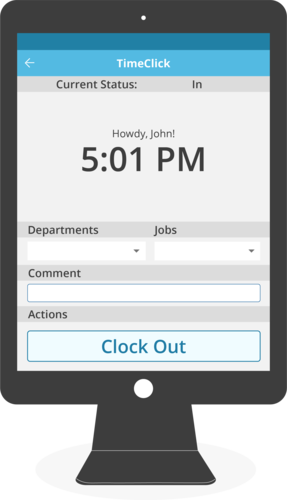
Can TimeClick Fulfill All Your Needs?
TimeClick is an employee time clock software and time clock app that tracks and reports employee time quickly and accurately. It's incredibly easy to use, affordable, and perfect for smaller businesses. You can even create your own employee kiosk with our time clock app if you were considering getting an employee kiosk. If you are interested in trying TimeClick, check out our 14-day free trial.
Final Thoughts
If you have any questions about TimeClick, feel free to chat with one of our friendly sales reps at (435) 753-4102 ext. 1 or sales@timeclick.com.
Ready to streamline your employee time tracking, boost productivity, and simplify payroll? Sign up for your FREE 14-day trial today and see how TimeClick can transform your business!
Start your FREE TimeClick Trial Today.
